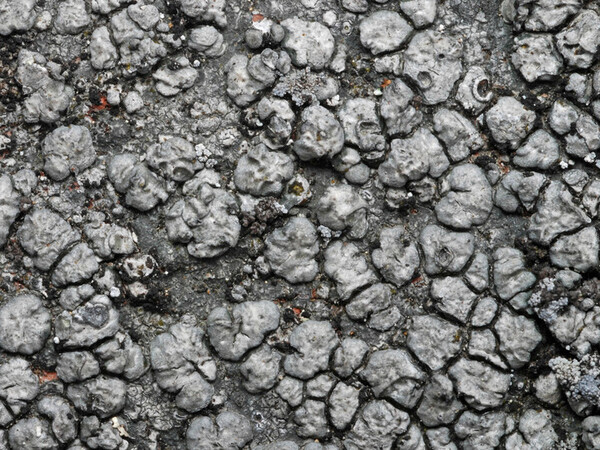Circinaria gibbosa (Ach.) A. Nordin, Savić & Tibell
Mycologia, 102: 1346, 2010. Basionym: Urceolaria gibbosa Ach. - Meth. Lich.: 144, 1803.
Synonyms: Aspicilia gibbosa (Ach.) Körb.; Lecanora gibbosa (Ach.) Nyl.
Description: Thallus crustose, episubstratic, verrucose-areolate, yellowish grey to bluish-grey, sometimes delimited by a dark prothallus, the areoles 0.6-1 mm wide, usually rounded, convex, developing on a dark hypothallus. Medulla white, filled with crystals, opaque, I-. Apothecia aspicilioid, 0.3-0.6 mm across, immersed, usually 1 per areole, with a black, epruinose, flat disc, and a very thin, persistent, often split thalline margin. Proper exciple poorly developed, colourless, up to 25 µm wide; epithecium olive green to olive-brown, N+ green, K+ yellow-brown; hymenium colourless, 120-150(-185) µm high, I+ blue or sometimes partly turning yellow-green; paraphyses 7-2.5 µm thickat mid-level, slightly branched, anastomosing and submoniliform in upper part, the apical cells to 3.5 µm wide; hypothecium colourless, I+ blue. Asci 6-8-spored, cylindrical-clavate, the thin outer coat K/I+ blue, the wall and apical dome K/I-. Ascospores 1-celled, hyaline, broadly ellipsoid to subglobose, 20-26 x 12-14(-18) µm. Pycnidia partially immersed, with a black, punctiform ostiole. Conidia thread-like, 6-8 x c. 1 µm. Photobiont chlorococcoid. Spot tests: cortex K-, C-, KC-, P-; medulla K+ yellow turning red (needle-like red crystals), but only after pretreatment with HCl. Chemistry: aspicilin, medulla with norstictic acid in low concentrations.
Growth form: Crustose
Substrata: rocks
Photobiont: green algae other than Trentepohlia
Reproductive strategy: mainly sexual
Commonnes-rarity: (info)
Alpine belt: very rare
Subalpine belt: rare
Montane belt: very rare
Dry submediterranean belt: absent
Humid submediterranean belt: absent
Padanian area: absent
pH of the substrata:
1 2 3 4 5
Solar irradiation:
1 2 3 4 5
Aridity:
1 2 3 4 5
Eutrophication:
1 2 3 4 5
Poleotolerance:
0 1 2 3
Altitudinal distribution:
1 2 3 4 5 6
Rarity
absent
extremely rare
very rare
rare
rather rare
rather common
common
very common
extremely common
Loading data...
Occurrence data
Predictive map
Growth form: Crustose
Substrata: rocks
Photobiont: green algae other than Trentepohlia
Reproductive strategy: mainly sexual
Commonnes-rarity: (info)
Alpine belt: very rare
Subalpine belt: rare
Montane belt: very rare
Dry submediterranean belt: absent
Humid submediterranean belt: absent
Padanian area: absent
pH of the substrata:
| 1 | 2 | 3 | 4 | 5 |
Solar irradiation:
| 1 | 2 | 3 | 4 | 5 |
Aridity:
| 1 | 2 | 3 | 4 | 5 |
Eutrophication:
| 1 | 2 | 3 | 4 | 5 |
Poleotolerance:
| 0 | 1 | 2 | 3 |
Altitudinal distribution:
| 1 | 2 | 3 | 4 | 5 | 6 |
Rarity
absent
extremely rare
very rare
rare
rather rare
rather common
common
very common
extremely common
Loading data...
Occurrence data
Predictive map







